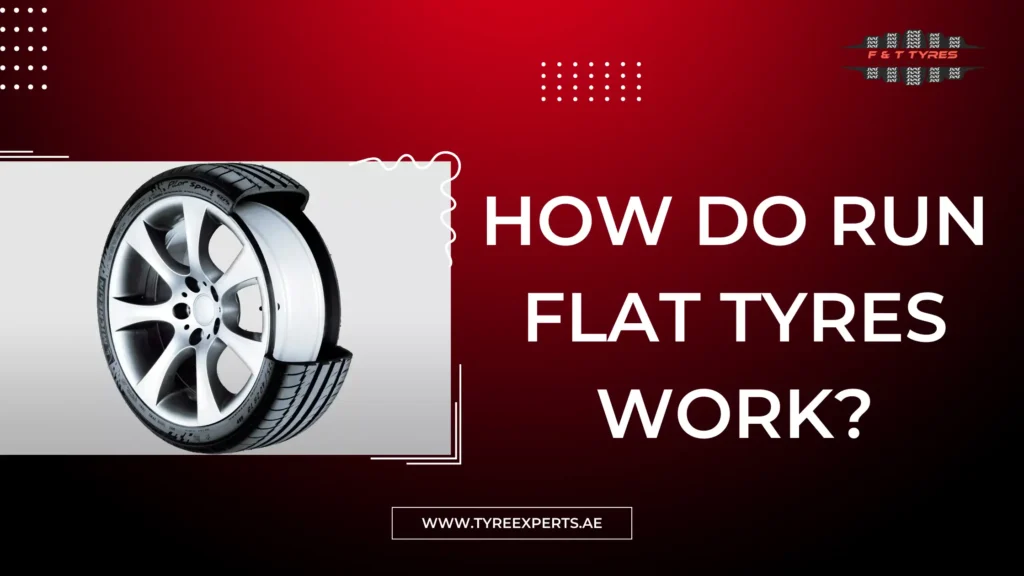Run flat tyres have revolutionized the way we think about vehicle safety and convenience. They are designed to keep a vehicle moving even after a puncture, which can be a lifesaver in precarious situations. But how exactly do run flat tyres work? This comprehensive guide delves into the technology behind these innovative tyres, their benefits, and considerations for vehicle owners.
Understanding Run Flat Tyres
Run flat tyres (RFTs) are a type of tyre specifically designed to resist the effects of deflation when punctured. This capability allows the driver to continue driving for a limited distance at a reduced speed, typically 50 miles at 50 mph, providing ample time to reach a safe location or service station.
Types of Run Flat Tyres
There are primarily two types of run flat tyres:
- Self-Supporting Tyres: These tyres have reinforced sidewalls that can support the weight of the vehicle even when air pressure is lost. The robust construction prevents the tyre from collapsing and allows continued operation.
- Support Ring Tyres: These tyres feature a ring of hard rubber or another structure inside the tyre, which supports the vehicle’s weight in the event of air loss. This design is often used in conjunction with specially designed wheels.
How Run Flat Tyres Work?
The core technology behind run flat tyres involves their ability to maintain their shape and functionality without air pressure. Here’s a closer look at the mechanisms at play:
Reinforced Sidewalls
The most common type of run flat tyres uses reinforced sidewalls. These tyres are constructed with additional layers of rubber and other materials to strengthen the sidewalls. When a puncture occurs and air pressure drops, the sidewalls remain rigid and can support the vehicle’s weight. This rigidity prevents the tyre from collapsing, allowing the vehicle to be driven for a short distance.
Internal Support Structure
Some run flat tyres use an internal support structure, such as a ring of hard rubber. This ring supports the vehicle’s weight in the event of a puncture. When air pressure is lost, the ring bears the load, maintaining the tyre’s shape and enabling the driver to continue driving.
Heat-Resistant Materials
Run flat tyres are made with heat-resistant materials to cope with the increased friction and heat generated when driving on a deflated tyre. This ensures that the tyre does not overheat and deteriorate quickly, allowing for safe travel to a service location.
Advantages of Run Flat Tyres
Run flat tyres offer several benefits, making them an attractive option for many drivers:
- Safety: One of the most significant advantages is the safety they provide. In the event of a puncture, drivers can maintain control of their vehicle and avoid the dangers associated with changing a tyre on the roadside.
- Convenience: Run flat tyres eliminate the need for immediate roadside tyre changes. This can be particularly beneficial in bad weather, on busy highways, or in unsafe areas.
- Space-Saving: Vehicles equipped with run flat tyres do not require a spare tyre, freeing up valuable trunk space for other uses.
- Improved Stability: Even when deflated, run flat tyres maintain better stability and handling compared to standard tyres. This reduces the risk of accidents and provides a smoother driving experience.
How Much Does Runflat Tyres Cost?
The runflat tyres prices can vary significantly depending on the brand, size, and type of tyre. On average, you can expect to pay between $150 to $400 per tyre. Premium brands or specialized models can cost even more. While run flat tyres are generally more expensive than standard tyres due to their advanced technology and materials, many drivers find the added safety and convenience worth the extra expense. For an exact price, it’s best to consult with tyre retailers or your vehicle manufacturer to get recommendations tailored to your specific vehicle and driving needs.
Considerations and Limitations
Despite their benefits, run flat tyres also comes with some considerations and limitations that potential buyers should be aware of:
- Cost: Run flat tyres are generally more expensive than standard tyres. The advanced technology and materials used in their construction contribute to the higher price.
- Ride Comfort: Some drivers report a stiffer ride with run flat tyres due to their reinforced structure. This can result in a less comfortable driving experience, particularly on rough roads.
- Limited Range: While run flat tyres allow continued driving after a puncture, they are not a permanent solution. Drivers must still seek tyre repair or replacement as soon as possible.
- Availability: Not all tyre shops carry run flat tyres, which can limit options when replacement is needed. Additionally, some vehicles may require specific run flat tyre models, further restricting availability.
- Repairability: Run flat tyres are often more challenging to repair than standard tyres. In many cases, a punctured run flat tyre will need to be replaced rather than repaired.
Vehicle Compatibility
Not all vehicles are compatible with run flat tyres. Typically, vehicles need to be equipped with a tyre pressure monitoring system (TPMS) to alert the driver when tyre pressure drops. This system is crucial because the reinforced structure of run flat tyres can make it difficult to detect a puncture visually.
Manufacturers such as BMW, Mercedes-Benz, and Mini often include run flat tyres as standard or optional equipment on their vehicles. However, before switching to run flat tyres, it’s essential to consult the vehicle’s manufacturer or a tyre specialist to ensure compatibility.
The Future of Run Flat Tyres
The technology behind run flat tyres continues to evolve, with manufacturers working to address some of the current limitations. Innovations aim to improve ride comfort, reduce costs, and increase the distance that can be traveled on a deflated tyre.
Run Flat Tyres vs. Traditional Tyres
To make an informed decision about whether to choose run flat tyres or traditional tyres, it’s essential to weigh the pros and cons:
Pros of Run Flat Tyres
- Enhanced safety and control after a puncture.
- Eliminates the need for a spare tyre.
- Provides peace of mind, particularly in unsafe or inconvenient locations.
Cons of Run Flat Tyres
- Higher cost.
- Potentially a less comfortable ride.
- Limited driving range after deflation.
- Potential difficulty in finding replacements or repairs.
Pros of Traditional Tyres
- Generally more affordable.
- Often provide a more comfortable ride.
- Easier to repair in many cases.
Cons of Traditional Tyres
- Immediate action is needed after a puncture.
- Requires carrying a spare tyre, reducing trunk space.
- Potential safety risks during roadside tyre changes.
Maintenance and Care
Proper maintenance of run flat tyres is crucial to maximizing their benefits and lifespan. Here are some tips for caring for your run flat tyres:
- Regular Inspections: Regularly check your tyres for signs of wear, damage, or punctures. This is especially important because run flat tyres can sometimes mask the severity of a puncture.
- Monitor Tyre Pressure: Always ensure your tyres are properly inflated according to the manufacturer’s specifications. The TPMS will alert you to significant pressure drops, but routine checks are still recommended.
- Rotate Tyres: Regular tyre rotation helps ensure even wear and extends the lifespan of your tyres. Follow your vehicle manufacturer’s recommendations for rotation intervals.
- Professional Inspections: Have your tyres inspected by a professional at least once a year or if you notice any issues with handling or ride quality.
Conclusion
Run flat tyres represent a significant advancement in tyre technology, offering enhanced safety and convenience for drivers. By understanding how they work, their benefits, and their limitations, you can make an informed decision about whether they are the right choice for your vehicle.
While run flat tyres may come at a higher cost and potentially offer a stiffer ride, the peace of mind they provide in emergencies can be invaluable. As technology continues to advance, we can expect even more improvements in the performance and availability of run flat tyres.
Frequently Asked Questions
What Are Run Flat Tyres?
Run flat tyres are specially designed tyres that allow a vehicle to continue being driven even after a puncture or loss of air pressure. They are constructed with reinforced sidewalls or an internal support structure that can support the vehicle’s weight, allowing the driver to reach a safe location for repair or replacement.
How Far Can I Drive on A Run Flat Tyre After a Puncture?
Most run flat tyres allow you to drive up to 50 miles at a reduced speed of 50 mph after a puncture. However, it’s essential to consult the specific tyre manufacturer’s guidelines as distances and speeds can vary depending on the tyre model.
Are Run Flat Tyres More Expensive than Regular Tyres?
Yes, run flat tyres are generally more expensive than traditional tyres. The advanced technology and materials required to manufacture run flat tyres contribute to their higher cost. However, the added safety and convenience they offer can justify the investment for many drivers.
Can Run Flat Tyres Be Repaired?
Repairing run flat tyres can be more challenging than repairing standard tyres. In many cases, a punctured run flat tyre will need to be replaced rather than repaired. It’s crucial to have the tyre inspected by a professional to determine if it can be safely repaired.
Do I Need a Special System in My Vehicle to Use Run Flat Tyres?
Yes, vehicles using run flat tyres typically need to be equipped with a tyre pressure monitoring system (TPMS). This system alerts the driver when the tyre pressure drops, which is essential because the reinforced structure of run flat tyres can make it difficult to detect a puncture visually.



